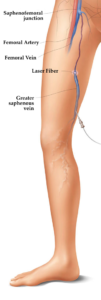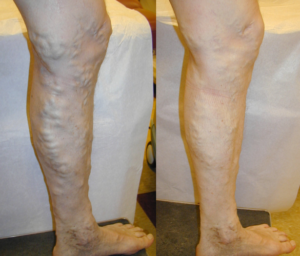Endovenous Laser Ablation
Endovenous Laser Ablation
Endovenous laser ablation (commonly referred to as “EVLA” or “EVLT”) describes a minimally invasive treatment where laser heat energy is used to seal abnormal, refluxing veins shut. Heat energy delivered from the laser targets the lining of these problem veins and closes them, compared to previous techniques where the refluxing veins were tied off and cut out in a more invasive manner. This older surgical treatment for vein disease was known as vein stripping. With its high rate of effectiveness, minimally invasive nature and requirement of only a local anesthetic, the EVLA is the treatment of choice for superficial venous insufficiency.
How is EVLA performed?
During this procedure after local anesthetic is administered, a catheter is placed in the thigh or leg, and a laser fiber is introduced through the catheter into the diseased vein. After the fiber is threaded through the diseased vein with ultrasound guidance, the area of the lower extremity to be treated is anesthetized locally. Because of the application of a local anesthetic before insertion of the catheter, this procedure is minimally painful.
Once in place, the laser tip is turned on and slowly withdrawn from the vein and out from the same site from which it entered. As heat is applied to the inner walls of the vein from the laser as Dr. Krysinski fires it, the walls react to this heat and seal the refluxing vein shut. After the vein is completely sealed, it will become scar tissue and begin to break down and reabsorb back into the surrounding tissues over the weeks to months that follow.
After the Procedure

After the procedure is finished, the procedure site is dressed with bandages. Then compression hose are applied to the treated leg. Patients generally wear compression hose for approximately two weeks postoperatively. Immediately following each surgical procedure, we ask the patient walk on our treadmill for about fifteen minutes prior to leaving the office. The following day, the patient returns to our office for a brief surgical follow-up visit where the bandages are removed, and a focused ultrasound of the treatment area is performed. Post-procedure instructions are then given to the patient before discharge home. Generally, after the follow-up visit is completed the patient schedules his or her next procedure.
What to Expect After an EVLA?
The treated leg often aches and feels sore postoperatively. The duration of aching varies from patient to patient and from one procedure to the next. Some patients will need to take non-steroidal anti-inflammatories (NSAIDs) such as ibuprofen after the procedure. Many patients do not need to take any NSAIDs however. Generally the post-procedural discomfort peaks around 3-5 days postoperatively as the swelling in the treatment area reaches its peak.
We encourage patients to walk as much as possible postoperatively as walking increases blood flow and improves the discomfort. Compression stockings are advised for 7-14 days on average after each procedure.
Call Vein Institute of Pittsburgh℠ today and schedule your ultrasound examination, and live well with healthy veins.
Learn More
Advantages of EVLA
- There is little to no downtime postoperatively.
- You are able to resume most of your normal daily activities the same day.
- There is minimal scarring, if any.
- Treatment time generally takes one hour.
- Unlike traditional vein stripping methods, no hospital stay is required and no general anesthesia is used.
- Success rates of up to 97%.

